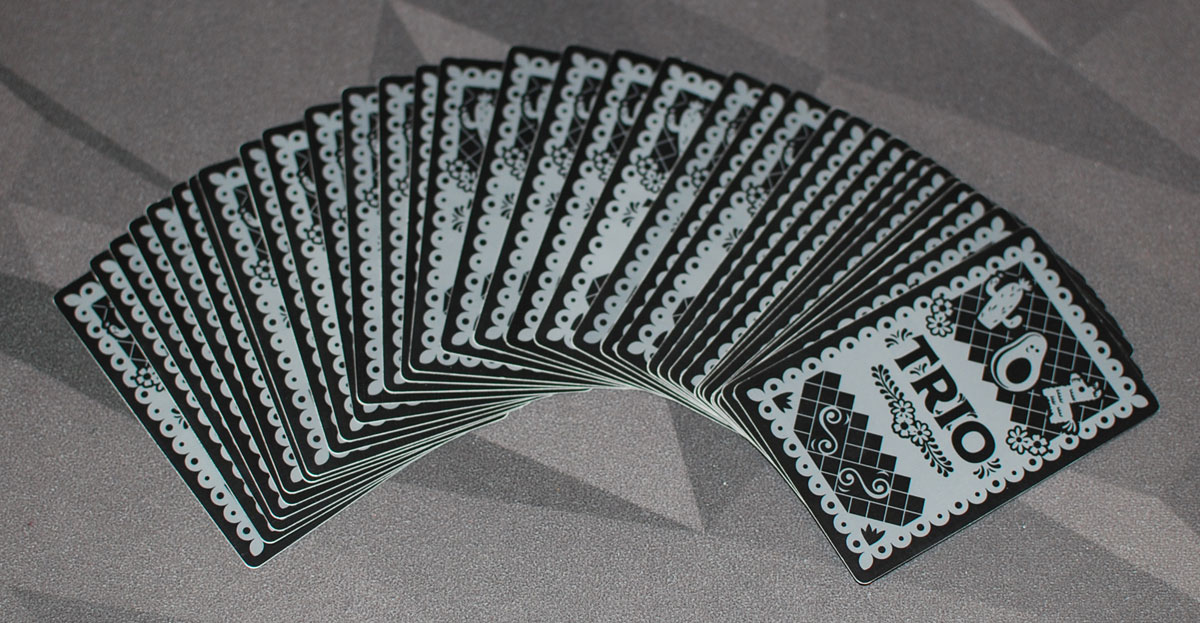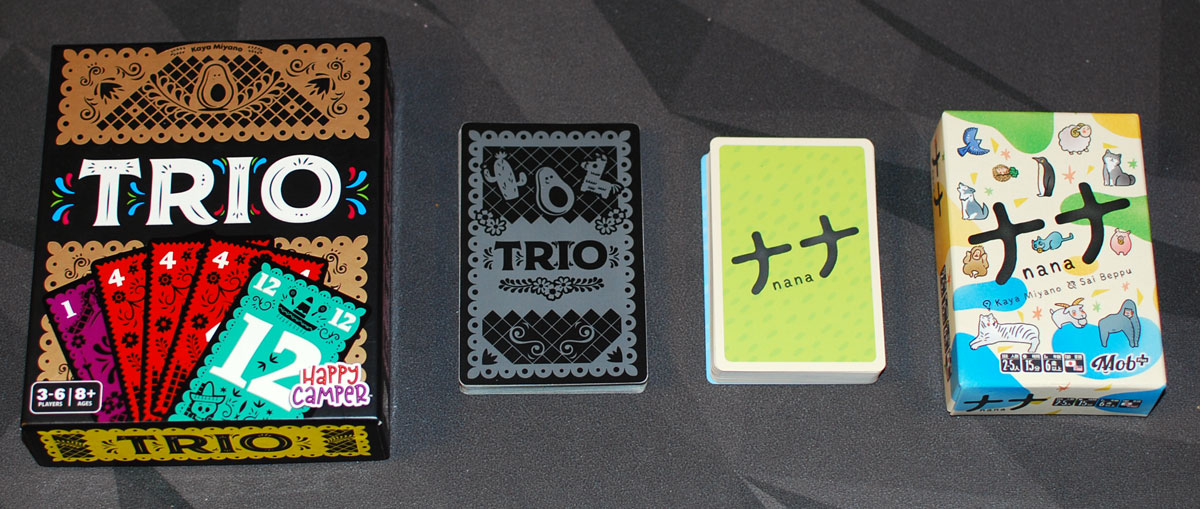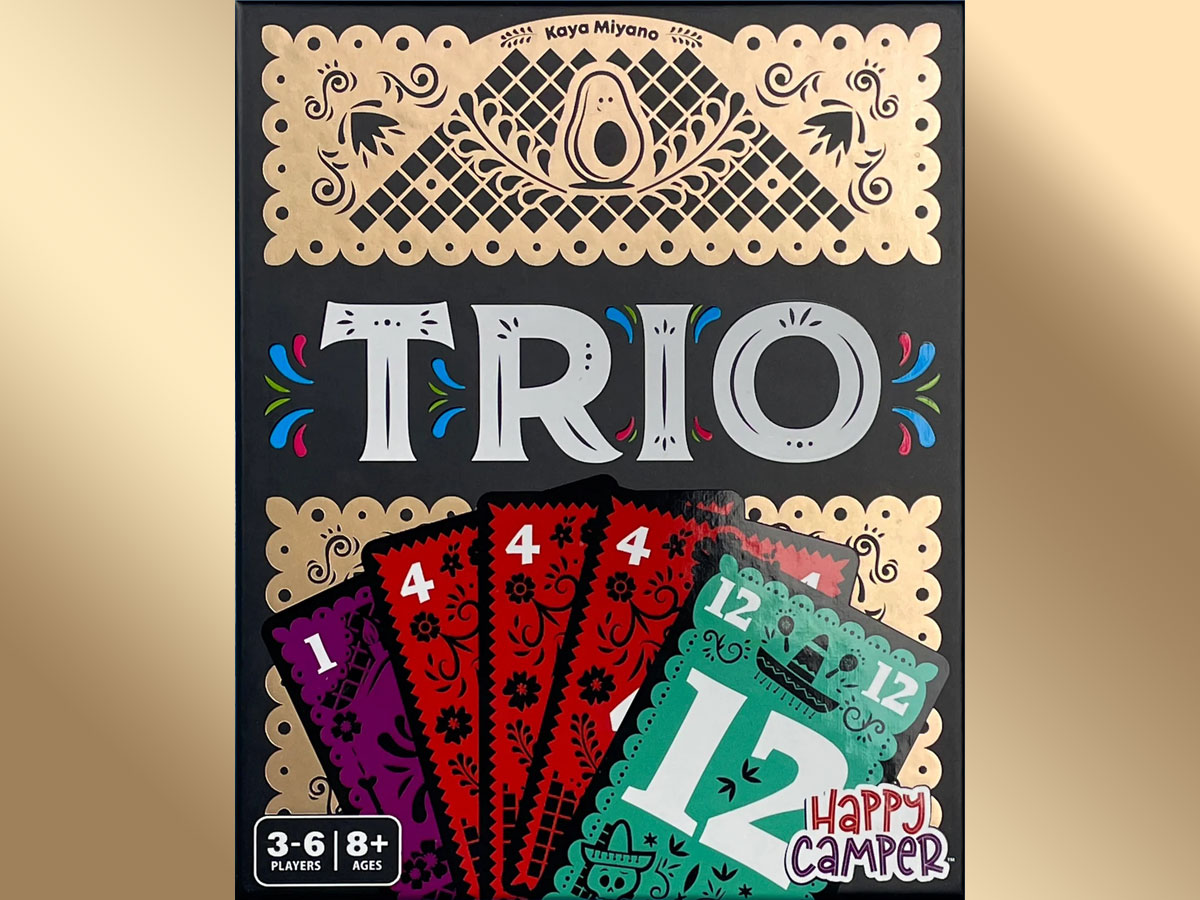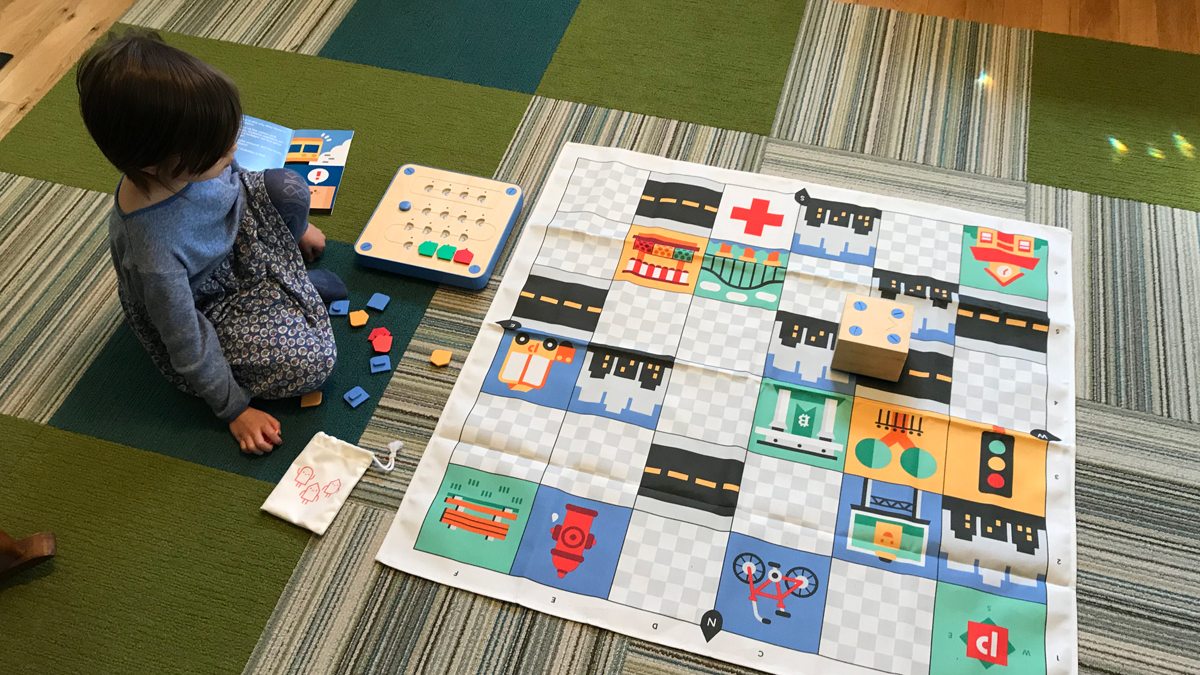Got a few minutes? Then you have time to play Trio!
What Is Trio?
Trio is a quick card game game for 3 to 6 players, ages 8 and up, and takes about 15 minutes to play. It retails for $14.99 and is available in stores or directly from Happy Camper Games. Trio has some similarities to Go Fish and Memory, so it’s definitely kid-friendly, and you could even go a little younger than 8, as long as they know their numbers.
Trio was designed by Kaya Miyano and published by Happy Camper Games, with illustrations by Laura Michaud. It was originally published as nana a couple years ago in Japan (“nana” means “7” in Japanese); Trio is a new US edition with different artwork and slightly different rules.
New to Kickstarter? Check out our crowdfunding primer.

Trio Components
Trio consists of just 36 cards, three copies of each number from 1 to 12. The cards are an odd size: about the width of a standard poker card, but slightly taller, which makes them feel oversized even though the actual size difference is minimal. Each card has the number printed very large in the center of the card as well as both top corners, and then one or two small card icons in the bottom corners, which are used in the “spicy” variant. The cards are illustrated to look like papel picado, the Mexican cut-paper artwork. One nice thing is that aside from having the number prominently displayed in the center of the card, each number has a different colored background as well. The “7” cards have gold foil and are extra shiny.

Trio comes in a small box, though even this box is much larger than it actually needs to be. If you took out the cardboard insert, you could probably fit at least 6 copies of the game in this box; even the insert could probably hold 3 copies. But that’s the US market for you—games in smaller boxes are harder to sell to stores. Contrast this with the Japanese edition (which a friend of mine owns): it uses regular sized cards, and although its box is also slightly larger than needed, it easily fits in a pocket.

How to Play Trio
You can download a copy of the rulebook here.
The Goal
The goal of the game is to find three trios (a 3 of a kind); there’s an optional goal in the “spicy” variant described below. In either variant, you can also win by finding the trio of 7s.
Setup
Shuffle all the cards and deal cards to each player depending on the player count; there will be some cards remaining, which are placed face-down in the center of the table. All players should arrange their own cards from lowest to highest while keeping them secret from other players.

Gameplay
On your turn, you reveal cards one at a time, using two options: You may flip any card in the center of the table. Or, you may pick any player (including yourself) and ask that player to reveal their highest or lowest card by placing it face-up on the table. Important: no player may ever reveal a card that isn’t either the highest or lowest card in their hand. You may, however, ask the same player again—for instance, if they revealed their lowest card and it’s a “3,” you may ask them to reveal their next lowest card if you think it’s also a “3.”

You may continue to reveal cards until either you find a trio and collect it, or if you reveal any cards that don’t match, at which point all cards are returned to where they came from. Either way, your turn is over and it’s the next player’s turn.
Game End
If you collect 3 trios, or the trio of 7s, you win!

Spicy Variant
In the spicy variant, you win by either collecting the trio of 7s or by collecting two “connected” trios. Trios are connected if the sum or difference between them is 7—for instance, the trio of 2s and the trio of 9s are connected. Connected trios are also indicated at the bottom corners of the cards, in case you don’t want to do the math.
Team Variant
If you have 4 or 6 players, you can also play a team variant with teams of 2, and you sit opposite your partner. All cards are dealt out with none in the middle.
After sorting your cards, you may swap one card with your partner, and this swap is the only communication you’re allowed to have with your partner.
Each time a team scores a trio, the other teams may make a swap.
Winning is the same as the basic game, either 3 trios (simple) or 2 connected trios (spicy), or the 7 trio.
Why You Should Play Trio
When a copy of Trio showed up in the mail for me from Happy Camper Games, I didn’t know much about either the game or the publisher, other than that the founder, Jason Schneider, had developed games for Gamewright for many years. That’s a pretty good pedigree—Gamewright titles are some of my favorites to recommend for families who are looking for games that work well with younger kids and adults playing together. Although Trio isn’t a Happy Camper original, I think it shows the type of game that Schneider is looking for.
I’m happy to say that Trio has been a blast to play, and I’ve introduced it to so many people in the past two months. It’s a snappy game that is pretty easy to teach, and the combination of luck and memory means that everyone’s got a chance to win and you feel like you’ve accomplished something when you do. I think it’ll be a great fit for groups that enjoy casual card games: minimal setup time and a short play time means you can play several rounds in a row, or break it out between longer games during game night.

I’ll reiterate here the only rule that players sometimes get wrong when they’re learning Trio: you can only play the highest or lowest card from a hand, even your own hand. So if you reveal that somebody else’s lowest card is a 4 and you have the other two 4s in your own hand, they’re stuck there if they’re not the highest or lowest cards in your hand.
I like the way that the game forces you to “peel away” the outer cards before you can get to the center. It also means that usually you don’t have to remember all of the cards that everyone has, just the highest and lowest. The twist is that the cards in the center of the table can be flipped in any order, so sometimes you can get lucky if you find a trio just by flipping cards. It’s also been fun to see how the game feels a little different at different player counts: with 3 players, everyone has 9 cards each so there are a lot of inaccessible cards at the beginning of the game. But in a 6-player game, everyone only has 5 cards, and the fact that they’re spread out over so many people means that right from the start you might have a chance at getting some of those more central numbers.
There’s a bit of fun bluffing that can happen, too—if you’re holding onto two copies of the same number, it should be easier to score, as long as you can figure out where the last one is before somebody realizes you’re doubling up. In some instances, after a few turns digging for the same number, it’ll become obvious to everyone who has the last one (or if it’s hidden in the center)—hope you’re lucky enough that it happens on your turn! The one piece of advice I give players is to reveal your own card last. I’ve seen many times a player confidently plays a card from their hand, calls for another player to reveal a card, and then … turns over the wrong card in the center. You’ve just given the next player a trio!
The main thing that bothers me about Trio—aside from the box size, which I’ve mentioned above—is the totally unnecessary dash of cultural appropriation. It’s really just an abstract number game—the original just had random cute animals as illustrations, because there isn’t really a theme to it. But when it got picked up for the European market and then the US market, it was given this Mexican retheme with no explanation that I’ve seen. The rules don’t make any attempt to tie the new illustrations to the game other than giving a first player rule: the person who most recently ate an avocado. The illustrations take the papel picado look and just throw in a random assortment of “Mexican” things: avocados! sombreros! pinatas! Luchador masks!
So, despite the fact that I love playing Trio, I also feel a little embarrassed when introducing it. I feel like by now game publishers and artists should know better, and I encourage them to get more feedback from people whose cultures they want to insert into their games. (I will note that I don’t know that Happy Camper Games specifically had anything to do with the art—it looks like it may be carried over from the French version of the game.) With a different set of illustrations, I would be more comfortable giving a whole-hearted endorsement of the game. As it is, I think a lot of families will enjoy playing Trio, and many of them probably would not even give a second thought to the artwork, but I hope this review might get them to stop and think about it too.
For more about Trio, visit the Happy Camper website.
Click here to see all our tabletop game reviews.
![]() To subscribe to GeekDad’s tabletop gaming coverage, please copy this link and add it to your RSS reader.
To subscribe to GeekDad’s tabletop gaming coverage, please copy this link and add it to your RSS reader.
Disclosure: GeekDad received a copy of this game for review purposes.






